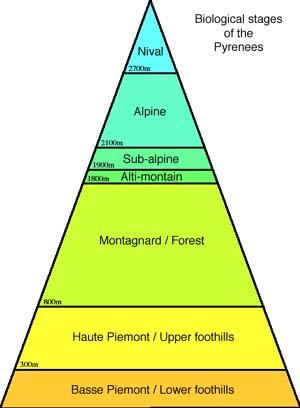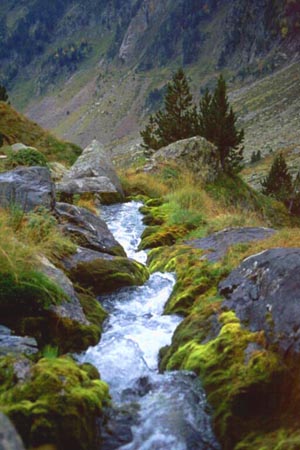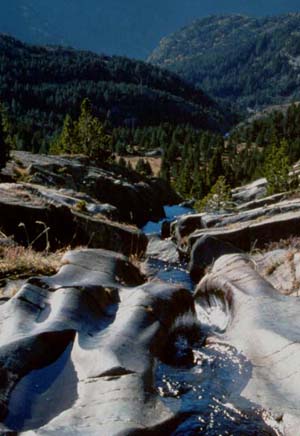Bibliography
Nature Notes
Nature is an especial interest of mine, and the observations made during the trek contribute to the body of the recount. For each stage, a nature note is presented for flora or fauna seen (or heard) during the trek, and wherever possible, during the respective stage. In fact, the western stages proved to be richer in sightings; this is true to reality for many species regardless of the season, but events would also diminish for:
- plantlife dies back or is obscured by snow cover
- insect life is perpetuated through larval stages
- some creatures hibernate
- many birds and animals migrate to lower levels or even to distant lands
Where a nature note relates to a sighting from another stage, it is referenced so (eg. S8, S21). The content of
all nature notes has been researched and an attempt has been made to aid identification through comparison with British species. Although the range is limited by what was actually seen, I have tried to choose those life-forms which are distinctive of the Pyrenees, and especially of the higher altitudes.
Nature notes refer to the
biological stages of the mountains, which are depicted in the diagram. The altitudes given can only be read as approximate for they vary with:
- Shelter from neighbouring peaks and slopes
- Exposition and orientation: septentrionale (N) or meridionale (S)
- Position within the range, from orientale (E) to occidentale (W)
Stage characteristics
The different biological stages are determined by climate and micro-climate; what follows is a brief attempt to identify the salient characteristics of each, along with some resident birds and mammals.
Nival
This is the stage which holds the glaciers and where snow fields linger through-out the year on northern slopes. Standing water is generally absent. It is not abundant in wildlife; some creatures based at lower levels will pass through. It cannot be said that the vultures live here for the sky is their home. They do however roost on ridges and crags at any level down to about 1500m, and nest on the more remote cliffs.
Alpine
This stage is affected by snow and extreme temperatures for much of the year, confining plant growth to a short season. It sustains life of mosses, lichens and grasses in all seasons; warmer months support several alpine flowers. Flowing water is in short supply. Birds characteristic of this stage include eagles, ptarmigan, alpine chough, and alpine swift, while marmot and isard represent the mammals.
Sub-alpine
This stage is characterised by the open pine forests of
pin a crochet and a diverse shrub layer which includes juniper, rhododendron, dwarf willows and myrtilles. These attract the micro-mammal rodents, squirrels, woodpeckers, finches, titmice and predating raptors. Small streams and boggy areas attract voles and amphibians.
Alti-montain
Deciduous trees thin out towards this altitude; the hardiest to survive as scattered woods are birch and
sorbus (ie. whitebeam and mountain-ash). This level attracts falcons, thrushes, buntings, pipits and the dipper where streams gather volume.
Forest
Beech and fir trees provide forest cover in this stage, along with maples, juniper and larch; oak, ash, wild cherry and chestnut grow well below 1000m. The forests support bears and wild pigs, squirrels, the martens and many others. Stars of the birdlife comprise capercaillie, woodpeckers (notably Gt. Black and White-backed), and owls (notably Eagle and Tengmalm's).
Upper Foothills
All forest trees grow in this stage, where habitat has often been modified by human presence. Buildings and gardens themselves create new possibilities for many species. A rich and diverse mix of wildlife may be present, depending on strength of the human
footprint.
Lower foothills
This stage merges into the plain which may often be devoid of tree-cover, especially where lower gradients facilitate human access. It is not essentially a mountain stage, but is included here for completeness.
Present but Unseen: birds and beasts
The species featured in the stage notes are further supplemented here for the reader's interest; the coverage of larger mammals is more complete for all mountain stages, while just a few birds of the upper mountain stages are named.
Mammalian life
Most mammals flee human presence and many are nocturnal. The
pine marten lives in the tree tops where it hunts squirrels and birds; its berry-stained scat may be seen in prominent position on rocks in the trail. That could however easily be confused with scat of its rufous-nosed relative, the
stone marten (
fouine) which generally lives at lower levels. The grey stippled
genet is a related to neither marten nor cat, but looks a bit like each; it has bred wild from escapees introduced from N Africa. The
wild cat is protected and has established itself well in the lower forests.
The doormouse has some interesting relatives here, although they are far from unique to the mountains. The grey bushy tailed
loire is almost squirrel sized and moves at least as fast; the thinner tailed & smaller
lérot wears a dark racoon like mask. Both 'tree rats' are denizens of woodland but are more likely to be seen around refuges where they can be as much of a nuisance as any rodent; however, their cute forms have winning appeal and few people trap them.
Red deer, weasel, ermine, polecat, badger, fox and hedgehog are all widespread in woodland, while the otter is present in certain rivers. Rabbits and hares inhabit the fringes, but these are more rarely seen than in Britain. The
chauve souris (bald mice!) must not be forgotten; 23 species of bat have been noted in the Pyrenean foothills and ten of these at altitudes up to 1800m. They range from the tiny Pipistrelle to the Greater Mouse-eared bat which has a wingspan of nearly half a metre.
Mammalian rarities
The trunk nosed
desman is a small aquatic mammal with a long snout; it is limited locally within the mountains to flowing streams of exceptional purity. A handful of curly horned
bouquetin may still be seen in region of the Ordesa gorge of Spain; hunting has decimated the spread and numbers of this mountain goat which was once common in the Pyrenees. The
brown bear is the largest carnivore present and its presence is well tracked and documented. Reliable evidence of the
lynx is hard to come by, but some may yet find refuge in western forests. Lastly, a vagrant
wolf on excursion from the Picos de Europa might be seen as often as a blue moon.
Avian life of the upper stages
Apart from those dicussed elsewhere, there are many other birds to look out for. Around the crags, the raven, kestrel and peregrine will often be present while the water courses favour grey wagtail and dipper. Open woodlands will attract the woodlark and tree-pipit, while pastures will provide for grey partridge and quail. Such is home also to the skylark, and in eastern parts of the range, a few rare breeding
dotterels. Bouldery pastures are habitat to the versatile wren and hedge-sparrow, keeping company with mountain specialists such as the rock bunting and wheatear.
A visit earlier in the season might reveal the handsome blue and russet
rock thrush in similar haunts; its courting flights and musical voice will give it away in the spring. Other migrants include the nocturnal
nightjar whose presence is given away by an incessant churring around dusk. The white-breasted
alpine swift visits for a brief summer, its larger size distinguish it from other swifts and swallows; of these, the adaptable house and crag martins may commonly be found at height. One of the larger migrants to breed in the Pyrenees is the pale
Egyptian vulture which favours the eastern end of the range. This is easily distinguished from its relatives since it is the smallest member of the family; its size places it between that the buzzard and the golden eagle, but the almost-white plumage will distinguish it from these.


